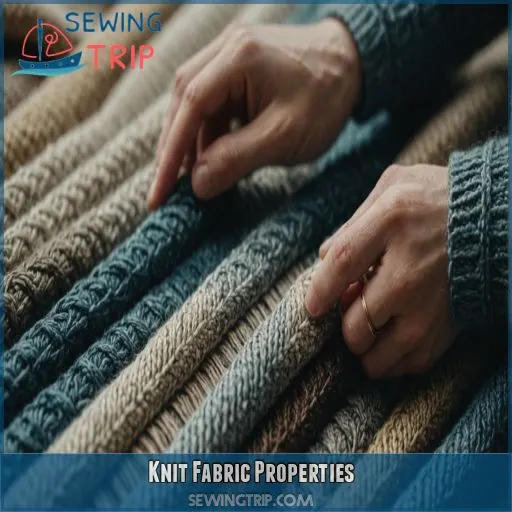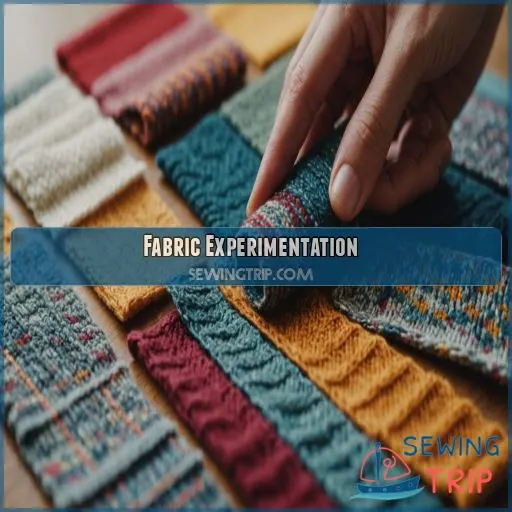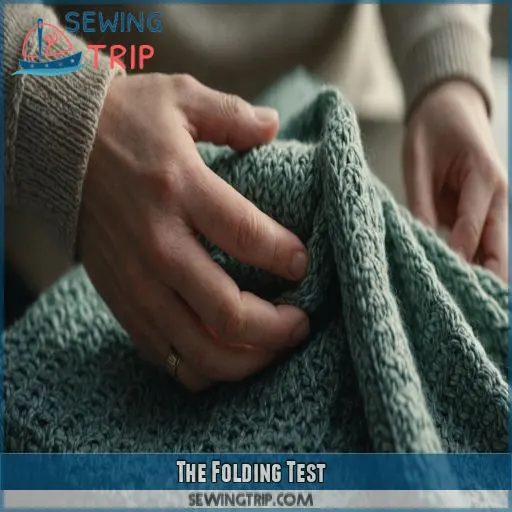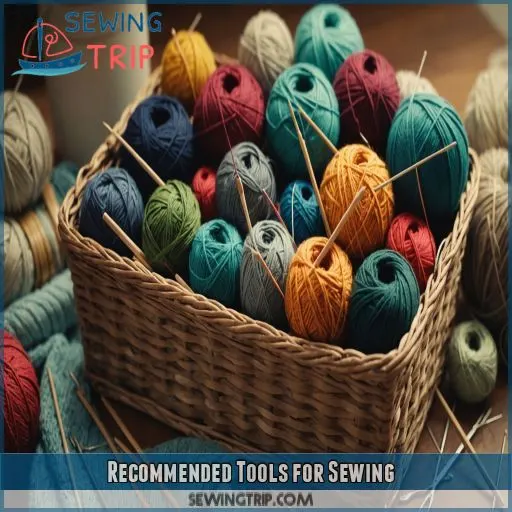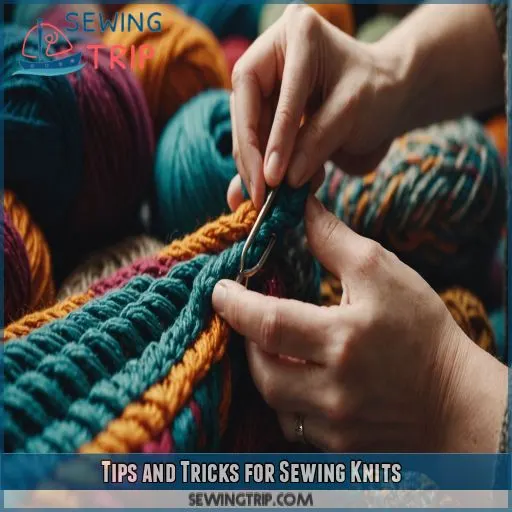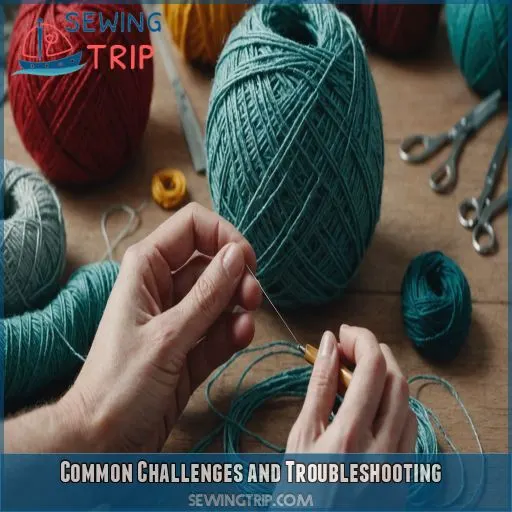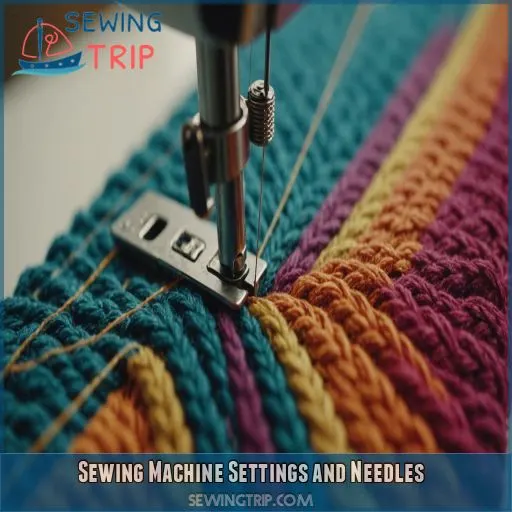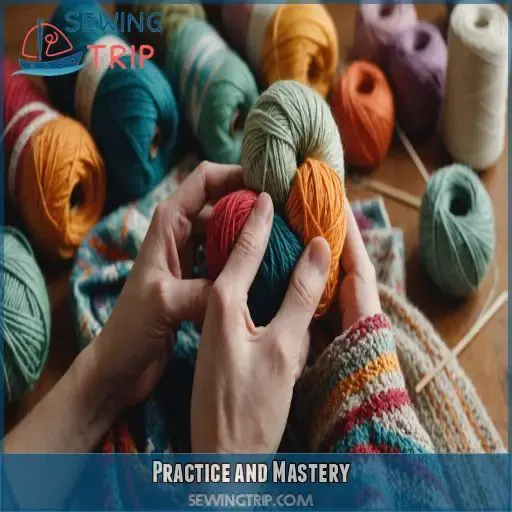This site is supported by our readers. We may earn a commission, at no cost to you, if you purchase through links.
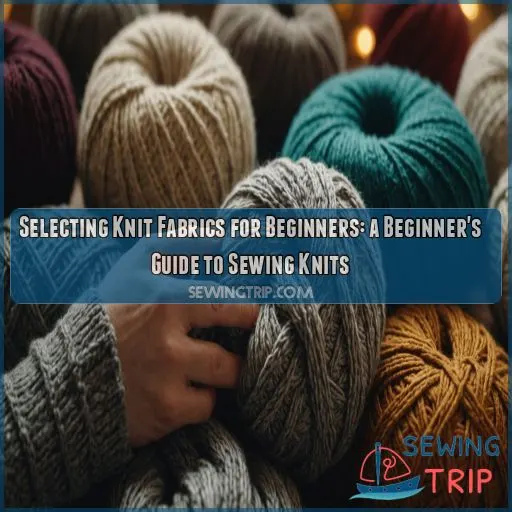 When selecting knit fabrics, consider weight, stretch, stability, and drape.
When selecting knit fabrics, consider weight, stretch, stability, and drape.
Lightweight knits are ideal for summer clothes, while heavier knits are best for winter.
Stretch refers to how much the fabric expands, and recovery is how well it bounces back.
Stable knits are easier to work with, but they may not drape as nicely.
You’ll want to experiment with different fabrics and try out the folding test to identify which are more stable.
Pre-washing and ironing your fabric are also key prep steps.
If you want more detail on sewing with knit fabrics, read on.
Table Of Contents
- Key Takeaways
- Choosing the Right Knit Fabric
- Knit Fabric Properties
- Fabric Experimentation
- The Folding Test
- Preparing Your Fabric
- Recommended Tools for Sewing
- Tips and Tricks for Sewing Knits
- Common Challenges and Troubleshooting
- Sewing Machine Settings and Needles
- Practice and Mastery
- Frequently Asked Questions (FAQs)
- Conclusion
Key Takeaways
- Weight, stretch, stability, and drape are key factors when choosing knit fabrics.
- Stable knits are easier to work with but may not drape as nicely, whereas unstable knits drape well but require more care when sewing.
- Pre-washing and ironing your fabric are essential prep steps to avoid shrinkage and keep your creation looking sharp.
- The folding test is a simple trick to identify stable knits that will be easier to work with and save you from sewing headaches.
Choosing the Right Knit Fabric
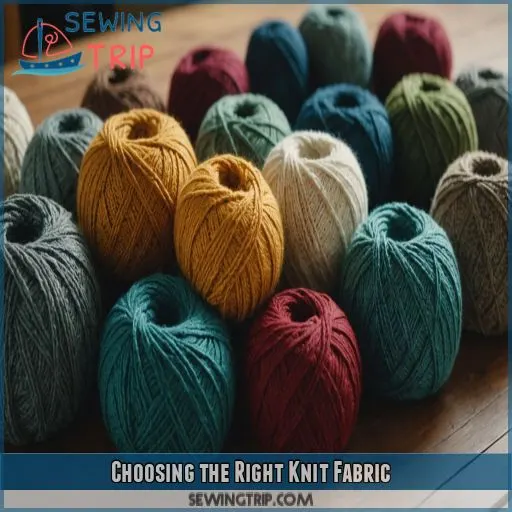
Choosing the right knit fabric is key to crafting a T-shirt that’s comfy, fits well, and looks great. You’ll want to think about factors like weight, stretch, recovery, and stability to find the perfect fabric for your project.
Weight and Thickness Matters
When choosing a knit fabric, weight and thickness matter a lot. These factors influence how the fabric drapes and the overall look of your T-shirt. Here are some key points to keep in mind:
- Lightweight knits: These are ideal for summer garments, as they’re breathable and drape beautifully. However, they may require more care during sewing due to their instability.
- Midweight knits: They offer a balance between drape and structure, making them a versatile choice for T-shirts.
- Heavier knits: Perfect for colder weather clothing, providing warmth and structure. However, they may be less suitable for draping styles.
Stretch and Recovery Explained
Stretch and recovery are key factors when choosing a knit fabric for your project. Stretch refers to how much the fabric can expand, and recovery is how well it returns to its original shape. Here’s a table to explain the different types of stretch and their characteristics:
| Stretch Type | Direction | Fabric Example |
|---|---|---|
| 2-Way Stretch | One Direction | Jersey Knit |
| 4-Way Stretch | Both Directions | Spandex |
| Mechanical Stretch | One Direction, Created by Weaving Techniques | Canvas |
When selecting a knit fabric, consider the amount of stretch needed for your desired fit and style. Fabrics with higher elastane content usually have better recovery, so they’re less likely to warp or sag over time.
Stability and Drape Considerations
When choosing a knit fabric, consider its stability and drape. Stable fabrics retain their shape, making them easier to work with. Unstable knits drape well but require more care when sewing.
The stability of a knit fabric impacts its drape and overall look. A fabric with excellent drape falls and flows gracefully, adding fluidity to your garment.
Knit Fabric Properties
Knit fabrics have unique properties that set them apart. Let’s take a closer look at what makes knit fabrics special – things like stretch, drape, recovery, breathability, and warmth.
Understanding these properties will help you pick the right knit fabrics for your sewing projects, making sure your creations are both comfortable and stylish.
Stretch and Flexibility
When it comes to knit fabrics, stretch and flexibility are key. You want your fabric to move with you, not against you. Here’s the lowdown:
- Stretch types: You’ll encounter two-way stretch (stretching one way) and four-way stretch (stretching in both directions). It’s like the difference between a one-way street and a highway—both get you where you need to go, but one offers more freedom.
- Fabric recovery: This is like a fabric’s memory. You want it to snap back into shape after being stretched. Think of it as a rubber band—the better the recovery, the less chance of it losing its shape.
- Knit vs. woven: Knit fabrics offer more stretch and flexibility than their woven counterparts. It’s like comparing a yoga pant to a pair of jeans—both have their place, but knits give you that extra wiggle room.
Drape and Texture
Sewing with knit fabrics is all about how they drape and feel.
You want your pieces to hang nicely, with a soft, flowing look.
Knit fabrics can drape beautifully, but you need to think about their weight and thickness.
Lighter weight fabrics are perfect for summer clothes, while heavier knits are better for colder weather.
So, think about the season and the style you’re going for.
Go with what feels right and don’t be afraid to experiment.
Recovery and Stability
Recovery and stability are key factors when selecting knit fabrics. Recovery refers to how well a fabric bounces back to its original shape after being stretched, while stability is its resistance to warping and distortion. Here’s why they matter:
- Recovery is essential for maintaining the shape and fit of your garment over time. Poor recovery can lead to sagging and warping, especially in areas like necklines and seams.
- Stable knits are easier to work with and sew. They hold their shape well, reducing the risk of rippling seams and wonky necklines.
- The right balance of recovery and stability helps your T-shirt keep its intended shape and fit. Too much stability can restrict movement, while too little can lead to a messy final product.
Breathability and Warmth
For staying comfy, breathability and warmth are key. You want a fabric that keeps you cozy without making you sweat. Knit fabrics offer a happy medium, allowing air to circulate while retaining warmth. This makes them versatile for different seasons and climates.
Fabric Experimentation
Sewing with knit fabrics is a great way to experiment with different types of fabric. It’s a fun and educational way to learn about their unique properties and how they affect your projects. You’ll get a feel for how various fabrics behave and the impact they’ve on the final garment.
Lightweight Knit With Poor Recovery
Let’s say you’re thinking about sewing a T-shirt and you’ve picked out a lightweight knit fabric.
But this fabric has poor recovery, meaning it doesn’t bounce back to its original shape after being stretched.
What could go wrong? Well, quite a bit. You might end up with a warped neck binding and rippling seams—not the most flattering look.
To avoid this, it’s best to choose a fabric with better recovery, ensuring your T-shirt keeps its shape and fits like a dream.
Midweight Knit With Moderate Recovery
Let’s talk about midweight knit fabrics with moderate recovery. Here’s the lowdown:
- This type of fabric finds the sweet spot between lightweight and heavier knits, offering a balanced combination of stretch and stability.
- It’s a versatile option, perfect for T-shirt projects and beyond.
- You’ll get that comfy, snug feel without sacrificing breathability.
- The moderate recovery means your garment will keep its shape nicely, avoiding that warped and saggy look.
Heavier Knit With Excellent Stretch
Now, let’s talk about a heavier knit fabric with excellent stretch. This type of fabric is ideal for creating snug-fitting garments with perfect hems and necklines. Its stability and weight make it less suitable for draping styles, but it shines in providing structure and shape.
Imagine creating a form-fitting T-shirt that hugs your curves in all the right places. Go for a heavier knit with excellent stretch recovery for that extra "snap-back" power.
The Impact of Fabric Properties
The impact of fabric properties is huge. For instance, a lightweight knit with poor recovery and stability can result in a warped neck binding and rippling seams. On the other hand, a heavier knit with excellent stretch and stability can create a snug-fitting T-shirt with a perfect hem and neckline.
The Folding Test
Want to know a quick trick for picking the right knit fabric? Just fold it! You’ll quickly spot the stable knits that are easier to work with and will save you from a world of sewing headaches.
Identifying Stable Knits
When selecting knit fabrics for your sewing projects, it’s important to identify stable knits that will be easier to work with. Here’s a simple folding test to help you out:
1. The Folding Test:
Try folding different knit fabrics. Stable knits will fold neatly and retain their shape, while unstable knits tend to be messy and difficult to fold.
2. Look for Tidy Fabrics:
Go for fabrics that fold easily and maintain a tidy appearance. These are the ones that will be more forgiving as you sew.
3. Simplify Your Sewing:
Choosing stable knits can make your sewing projects less frustrating. They’re less likely to warp or distort, giving you more control over the final outcome.
Unstable Knits and Their Challenges
Unstable knits can be a challenge to work with, but with a bit of extra care, you can still create beautiful garments. These fabrics tend to drape well but can be tricky to handle due to their instability. You’ll want to pay close attention during the cutting and sewing process to avoid any warping or distortion.
| Challenge | Cause | Solution |
|---|---|---|
| Fabric warping | Unstable knit | Use a rotary cutter and cut fabric in a single layer |
| Stretching | Fabric handling | Pre-wash fabric and use a walking foot |
| Distortion | Sewing technique | Adjust tension and use a differential feed |
Simplifying the Sewing Process
The folding test is a simple trick to simplify your life when sewing with knit fabrics.
You can identify stable knits that are generally easier to work with.
Unstable knits tend to be messy and tricky to fold neatly.
So, if a fabric won’t cooperate and stay folded, it’ll probably give you trouble during sewing too.
Stable knits, on the other hand, fold neatly and hold their shape, making them a dream to work with and leading to a more professional-looking result.
Preparing Your Fabric
Getting your fabric ready is a big deal when you’re sewing. You want to wash, iron, and cut your knit fabric carefully so it’s ready to stitch.
Let’s talk about the right and wrong ways to handle knit fabric so you can start your project feeling good.
Pre-Washing and Drying
Pre-washing is a crucial step in preparing your knit fabric. It’s like a secret weapon against shrinkage and distortion. You don’t want your cozy T-shirt turning into a crop top after the first wash!
Here’s the lowdown on pre-washing and drying:
- Wash Temperature: Go for a cold or lukewarm setting. Avoid hot water, which can cause shrinkage and fading.
- Fabric Softener: Steer clear of it. Fabric softener can weaken the fibers and mess with the stretch of your knit fabric.
- Drying Methods: Air drying is your best friend. Tumble dryers can be risky due to the high heat. If you must use a dryer, opt for a low-heat setting.
Ironing and Cutting Tips
For ironing, keep the heat low to avoid damaging the fabric. As for cutting, sharp scissors or a rotary cutter are your best friends. Avoid using fabric softener—it can weaken the fibers and mess with the stretch. Fabric clips are also a safer bet than pins, which can leave holes.
Preventing Snagging and Stretching
When preparing your fabric, it’s important to use the right tools to avoid snagging and stretching. Opt for sharp scissors or a rotary cutter to make clean cuts and prevent accidental tugs on the fabric. Fabric clips are your new best friend—they’ll keep your fabric in place without leaving pesky holes like pins do.
Recommended Tools for Sewing
Now that you’ve picked your fabric, it’s time to get stitching. This section will cover the tools you’ll need to sew knit fabrics, from needles to machines.
Ballpoint Needles and Stretch Stitch
Sewing knit fabrics can be a bit tricky, but there are a couple of tools that’ll make your life a whole lot easier: ballpoint needles and a stretch stitch.
Ballpoint Needles
First up, ballpoint needles. These needles are designed with a rounded tip that pushes yarns aside, rather than piercing them like a sharp needle. This helps to prevent damage to the fabric and those dreaded skipped stitches.
Stretch Stitch
Next, you’ll want to use a stretch stitch. This type of stitch is designed to, you guessed it, stretch! It does this by creating a zig-zag pattern that can expand and contract with your fabric. No more popped seams or puckered stitches.
Walking Foot and Stabilizer
The walking foot is your best friend when sewing knits. It helps guide the fabric through your machine, ensuring an even feed. This is especially handy when working with slippery or stretchy knits, as it prevents the fabric from shifting or stretching out of shape.
Stabilizers are like a secret weapon for sewing knits. They add structure and stability to your fabric, making it easier to sew. There are two types: cut-away and tear-away. Cut-away stabilizers are ideal for knits that need long-lasting support, like necklines or hems. Tear-away stabilizers are perfect for temporary support and can be easily removed once you’re done sewing.
Serger and Overlock Machine
For sewing knit fabrics, a serger or overlock machine is your secret weapon. These machines are specifically designed to handle stretch fabrics, and they’ll give your projects a professional finish. Sergers use multiple threads to create a strong, stretchy seam, while overlock machines trim and finish seams in one go. They’re especially handy for sewing knits as they prevent wavy seams and provide a neat, durable finish.
If you’re new to sewing knits, don’t be intimidated by these machines. They’re easy to master with a bit of practice, and they’ll open up a world of possibilities for your projects. You’ll be whipping up T-shirts, leggings, and cozy sweaters like a pro!
Tips and Tricks for Sewing Knits
Now that you’ve got the lowdown on knit fabrics and the tools to tackle them, let’s get into some tips and tricks to level up your sewing game. From tension tweaks to needle know-how, these insights will have you stitching like a pro and creating knitwear masterpieces in no time.
Adjusting Tension and Stitch Length
When sewing knits, adjusting your sewing machine’s tension and stitch length is really important. You don’t want your fabric stretching or puckering, so play around with the tension settings until you find the sweet spot. Go for a slightly longer stitch length than you’d with woven fabric.
Using the Right Needles and Thread
Needles and thread? You’ve got options. The right combo depends on your knit fabric.
Go for a ballpoint or stretch needle. These are designed for knit fabrics and come in various sizes. As for thread, you’ve got choices, too. All-purpose polyester thread is a good bet for most knits. But if you’re working with a super-stretchy fabric, grab some textured nylon thread. It’s strong and stretchy—perfect for those yoga pants or a body-hugging dress.
Don’t forget to adjust your needle tension and stitch length to match your fabric. You might need to play around with the settings to get it just right.
Differential Feed and Tension Settings
When sewing knits, your serger’s differential feed and tension settings are important for success. These settings help you get smooth seams and stop them from puckering or stretching.
The differential feed controls how much fabric is fed through the machine, which affects how the seam looks. For knits, a lower setting is best to prevent wavy seams.
Tension settings are important too. Adjust them to match the stretch of your knit fabric. Too loose, and you’ll get loops; too tight, and you’ll see puckers. Experiment to find the right balance.
Common Challenges and Troubleshooting
Sewing with knit fabrics can present some unique challenges. You might encounter issues like wavy seams, stretching, or distortion. Don’t worry, we’ll tackle these problems head-on and offer solutions to keep your sewing projects on track.
Wavy Seams and Puckering
Wavy seams and puckering can be frustrating when sewing knit fabrics, but don’t worry—you can troubleshoot these common challenges!
- Tension is key: Adjust the tension on your sewing machine to prevent these issues.
- Stitch length matters: Try a slightly longer stitch length than you’d with woven fabric.
- Needles: Experiment with different needle types, like stretch needles, to find the best match for your fabric.
- Sewing machine settings: Play with differential feed settings to smooth out those wavy seams.
- Fabric choice: Remember, the right fabric choice can make all the difference.
Stretching and Distortion
N/A
Fabric Choice and Pattern Selection
Picking the right fabric and pattern is all about finding that sweet spot. You want to pick a knit fabric that complements your sewing pattern like peanut butter and jelly. Go for patterns labeled ‘beginner-friendly‘ or ‘sew over and over‘—they’re usually simpler and more forgiving.
Take the time to read the pattern’s recommended fabric content and weight. It’s like following a recipe—you gotta use the right ingredients. For example, imagine Closet Core Patterns suggesting using knits with 50% stretch for their Pietra Pants. So, make sure your fabric ticks those boxes.
Imagine your end goal, too. Are you dreaming of a flowy dress or a snug-fitting top? Pick a fabric that’ll drape or hug your body just right. Project inspiration pics can guide you here.
Sewing Machine Settings and Needles
Now that you’ve picked your fabric, it’s time to get your sewing machine and needles ready for knit fabrics. You’ll need to make some adjustments to your machine settings and choose the right needles to make sure your stitching looks good and professional.
Choosing the Right Needle Type
Needles are your best friend when sewing knit fabrics. The right needle type and size are key to sewing knit fabrics without snags or damage. Go for a ballpoint or stretch needle designed for knits. These needles have a rounded tip that glides between fabric yarns, preventing damage to the knit structure.
Think about needle size, too. For lighter knits, a smaller needle size (like 70/10) works best, while heavier knits call for larger needles (90/14 or even 100/16). This helps the needle puncture the fabric without causing runs or tears.
Twin or Double Needles Explained
Sewing with twin needles, or double needles, offers a unique set of benefits for working with knit fabrics. With two needles mounted side by side, these needles produce two parallel rows of stitching, adding a professional and decorative touch to your projects.
Twin needles are perfect for creating durable, stretchy hems on knit fabrics. The double row of stitching allows for extra flexibility, ensuring your hems move with the fabric. This is especially useful for garments like T-shirts, leggings, and other stretchy clothing.
Additionally, twin needles can be used for topstitching, adding a decorative element to your creations. Experiment with different stitch types and thread colours to create unique designs.
Specialty Feet for Knits
Specialty feet for your sewing machine can make sewing knits a breeze. A walking foot, for instance, is a game-changer. It helps feed the fabric through evenly, ensuring smooth stitching without puckers or stretches. This is especially useful for thicker knits or multiple layers.
Twin needles are another secret weapon. They create a professional-looking double stitch, perfect for hems and decorative topstitching. Play around with different needle types and foot adjustments to find what works best for your knit fabric.
Practice and Mastery
You’ve learned a lot about sewing with knit fabrics, from choosing the right type and preparing it, to using the right tools and troubleshooting common issues. Now, it’s time to put your knowledge into practice and master the art of sewing knits.
This section will guide you through exercises to hone your skills, from conquering your serger or overlock machine to creating beautiful knit garments with confidence.
Conquering Your Serger and Overlock
Now it’s time to tackle the serger and overlock machine. Don’t be intimidated by these powerful tools – with a bit of practice, you’ll be a pro at handling knit fabrics.
First, let’s talk about serger tension and overlock settings. These machines can be finicky, so it’s important to experiment with different thread types and tension settings to find the perfect combination for your knit fabric.
When it comes to edge finishes, the serger is your best friend. It creates strong, clean edges that won’t fray. Play around with different seam techniques, such as a three-thread or four-thread overlock stitch, to see which works best for your project.
Practice Exercises for Knit Fabrics
- Start with a simple project like a scarf using a lightweight knit fabric. Focus on perfecting your cutting, sewing, and finishing techniques. Straight seams and even hems are the goals here.
- Level up by constructing a basic T-shirt with a midweight knit fabric. Experiment with different stitch types and tension settings to find the sweet spot for a professional-looking finish.
- Try out a twin needle on your sewing machine. Create a neat, store-bought-quality hem on a scrap of knit fabric. You’ll be impressed with the results!
- Finally, create a cozy sweater using a heavier knit fabric. Pay close attention to the stretch and recovery of the fabric as you sew, ensuring a comfortable and flattering fit.
Mastering the Art of Sewing Knits
Sewing with knit fabrics can be challenging, but with practice, you can master it. Here are some tips to help you conquer any fears and become a knit-sewing pro:
| Sewing Tip | Explanation | Application |
|---|---|---|
| Tip 1 | Explanation 1 | Knit fabric projects |
| Tip 2 | Explanation 2 | Sewing knit seams |
| Tip 3 | Explanation 3 | Choosing knit fabric |
Frequently Asked Questions (FAQs)
Whats the best way to test a knits stability before buying?
A simple way to test a knit’s stability is the folding test. Unstable knits are messy and hard to fold, while stable knits fold neatly and hold their shape. Stay clear of knits that stay stretched.
How do I stop knit fabric from snagging or stretching?
To prevent snagging, fold your knitwear rather than hanging it. To avoid stretching, don’t hang knitwear on abrasive surfaces. Sort your laundry carefully and avoid washing knits with heavy fabrics or those with zippers.
What stitch length should I use for knits?
Use a slightly longer stitch length than you’d with woven fabric. For example, a 5 setting will give you 16 stitches per inch.
Can I use fabric softener when washing knit fabric?
It’s tempting to reach for the fabric softener when washing your knitwear, but it’s best to avoid it. Fabric softener can weaken the fibers and affect the stretch of your favorite knit.
How do I store knit fabric to avoid wrinkles?
Avoid over-crowding and fold your knitwear correctly before storing it in drawers. Hanging knitwear can cause misshaping or stretching.
Conclusion
Selecting knit fabrics is a breeze when you know what to look for.
This beginner’s guide has unpacked the ins and outs of choosing and sewing knit fabrics.
You’re now well-equipped to jump into your next project.
You’ve got the lowdown on weight, stretch, stability, and drape, and how these factors influence your fabric choices.
With this knowledge, you can confidently select knit fabrics that align with your sewing projects and personal style.

